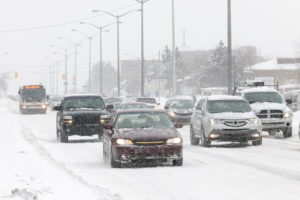 We don’t often think about the paint on our cars too much. As long as we wax it every once in a while and it doesn’t look bad, it goes without notice. Unfortunately, cars face adversity every day, and that often leads to paint damage that needs repair. If this happens in the winter, then you’re facing some unique challenges that can complicate the situation. Take a few minutes to learn about automotive paint and how it changes in the winter, and you’ll be better equipped to handle anything that comes your way.
We don’t often think about the paint on our cars too much. As long as we wax it every once in a while and it doesn’t look bad, it goes without notice. Unfortunately, cars face adversity every day, and that often leads to paint damage that needs repair. If this happens in the winter, then you’re facing some unique challenges that can complicate the situation. Take a few minutes to learn about automotive paint and how it changes in the winter, and you’ll be better equipped to handle anything that comes your way.
Cold Weather Is Hard on Cars
Owning a car means learning how to deal with the winter months every year. Once upon a time, this included changing to winterized fluids and a winter engine tune-up, but things are a little easier these days. What many car owners don’t realize is that winter conditions can wreak havoc on old or sloppy paint jobs. Extreme low temperatures can reveal inconsistencies in the paint and protective layers. They can cause small warping that will look like bubbles or striations within the paint layer.
Worse, winter weather often comes with salted roads. It’s no secret that salt is one of the toughest things your car has to endure, and the paint job is no exception. Consistent exposure to salt can erode thin spots in the paint, and it can corrode the body underneath. Keeping your paint job healthy is an extension of keeping your car healthy. For those reasons, you want to wash your car regularly and keep wax or other protective coatings in good condition.
New Paint Is Also at Risk
You might think that one of the best ways to protect your vehicle is to get a new paint job. This isn’t bad thinking, but painting a car in extreme cold comes with its risks. Many garages aren’t properly heated in winter months, and painting when the temperature is at or below freezing can ruin the paint itself. The low temperatures will affect the film thickness. When it gets disturbed, you’re likely to see a slew of tiny bubbles rise after the paint dries. Besides being unsightly, the bubbles weaken the paint’s integrity and keep it from adequately protecting your car.
Another issue that is easily overlooked is condensation. Even on a dry day, when the car moves from the cold outdoors to an adequately heated garage, a small, easily missed layer of condensation will form. If it isn’t properly handled, the water will change the adhesiveness of the paint and cause unevenness across the vehicle. When you’re searching for professionals to paint your car, make sure they’re prepared for cold weather.
Now that you understand the importance of your car’s paint, you can take measures to protect it. And, if necessary, you can get the paint repaired or redone to keep your car healthy in every season.
